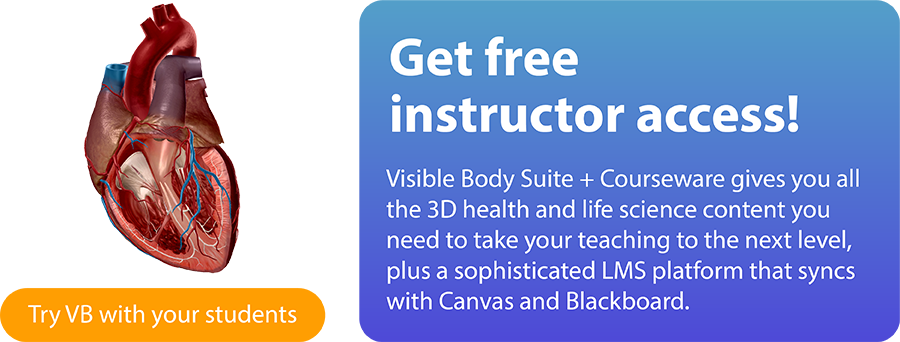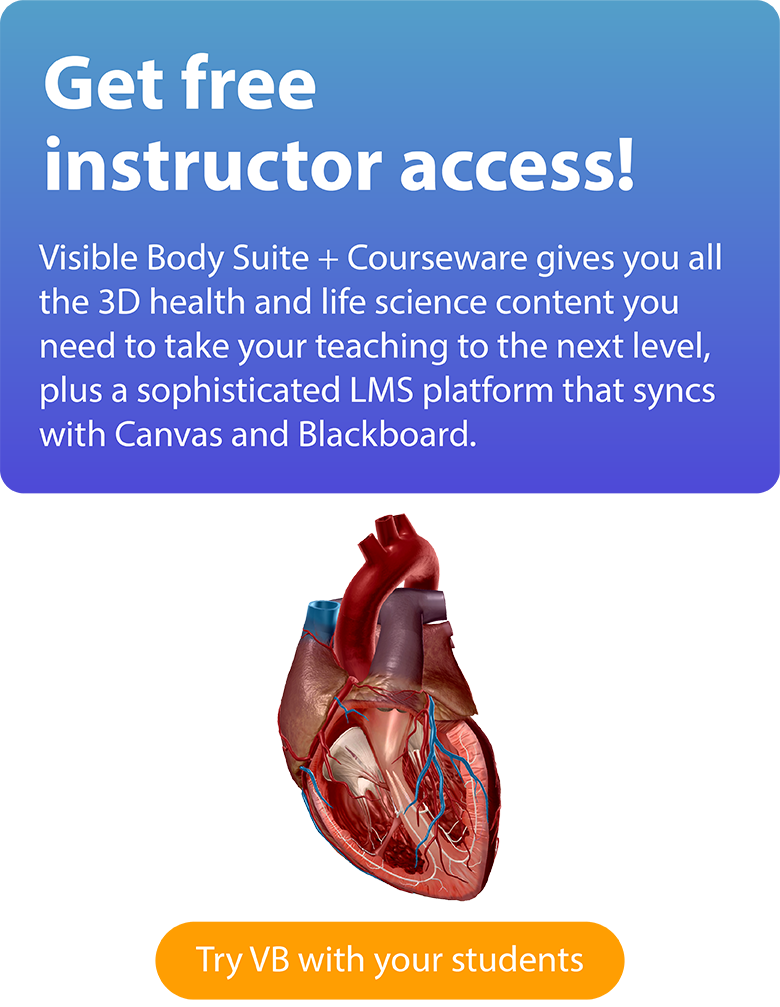Expertise + Collaboration: How Visible Body Ensures Quality Content
Posted on 6/21/24 by Sarah Boudreau
When creating educational resources, accuracy is the name of the game. We at Visible Body strive to create the best possible content that works on the widest range of devices, supported by the best premade curricula, through a stringent process of review, feedback, and testing.
Let’s take a look behind the scenes of how we generate ideas, create our content, and work with instructors each step of the way to ensure quality in Visible Body Suite and Courseware.
Model development
3D models are at the core of what we do, so it’s extremely important that they are accurate and align with how instructors actually teach. That’s why our whole process begins and ends with instructor feedback.
We get ideas for new content by looking at surveys and customer requests, then discussing those ideas with our group of instructor-reviewers—this ensures that the content we create is actually useful in the classroom. Working with those reviewers, we assemble a document that outlines the models and structures we want to see.
That outline then moves on to our in-house biomedical visualization team.
“All of our medical artists are academically trained, which means that each of our talented content creators have gone through rigorous schooling that combines art disciplines and biomedical science courses. This includes human anatomy courses with dissection along with other courses such as embryology, histology, and neuroanatomy,” explains Bert Oppenheim, Vice President of Creative Services.
The biomedical visualization team uses that outline and their own research to develop amazing, 3D visuals—first creating a grayscale model and then a fully-colored version. During this process, our editorial team composes the definitions and other text that accompanies the models.
 A behind-the-scenes look at the new 8-10 week fetus model coming this summer to VB Suite.
A behind-the-scenes look at the new 8-10 week fetus model coming this summer to VB Suite.
A panel of external reviewers provide feedback on the models multiple times during this process. When the model has received the final stamp of approval, it’s time to send the model and its associated content (like definition, Latin name, and pronunciation) to our software team. Visible Body’s software team then adds all of those assets into the product!
Testing across devices
The new models may be accurate and they may look great… but how do we know they actually work? That’s where our quality assurance (QA) engineers come in. Each software team has at least one QA engineer to make sure our products work great on a variety of different devices.
Our QA engineers work through comprehensive manual test plans across multiple devices in addition to automated testing to catch bugs and make sure that it’s smooth sailing for our customers.

QA testing on multiple devices!
In addition to keeping up with the latest updates from companies like Google, Apple, and Microsoft, four times a year we look at the devices customers use to access VB Suite and Courseware to make sure we stay up-to-date.
Students and instructors don’t always have access to the most up-to-date, cutting edge phones and laptops, so we want to ensure our products also work well on older devices, such as a student’s hand-me-down smartphone or the Chromebooks purchased by a school district.
Our systems requirements for Courseware and VB Suite account for both new devices and older ones.
Building curriculum
Visible Body creates more than software and 3D models—we also provide premade curriculum content that saves instructors time and effort! Our team works with instructor feedback to create
As an example, let’s take a look at the process for creating immersive assignments. In an immersive assignment, instructions guide students through 3D models, animations, simulations, and more as they progress through a series of activities and quizzes in Courseware. They create an “on the rails,” distraction-free online environment where students can move seamlessly through activities. Each premade immersive assignment is accompanied by learning objectives and state standards correlations.

An immersive assignment in Courseware.
We start by working with instructors to create an assignment outline with goals for learning, ideas for activities, and possible assessment criteria. That outline is then developed into a manuscript that lays out a series of bite-sized lessons connected to visual assets and assessments. Manuscript content is reviewed again by instructors.
After the manuscript is finalized, it’s time to work with the software team to bring the visual assets and quizzes into Courseware, sorting them by topic, subtopic, regions, and key terms to make it easy for instructors to find using the search function.
Then it’s time for one more review, and the final immersive assignment is released!
Seeing is believing
Are you an instructor or administrator interested in using Visible Body in your classroom? Try it for yourself! Click the banner below for a free instructor trial.


Make sure to subscribe to our email newsletter to keep updated on what’s new at Visible Body!
Be sure to subscribe to the Visible Body Blog for more anatomy awesomeness!
Are you an instructor? We have award-winning 3D products and resources for your anatomy and physiology course! Learn more here.



